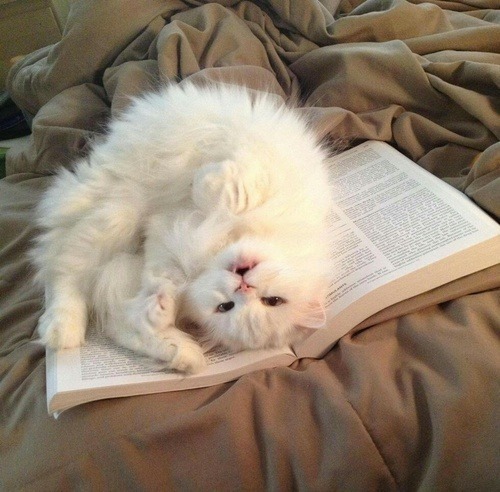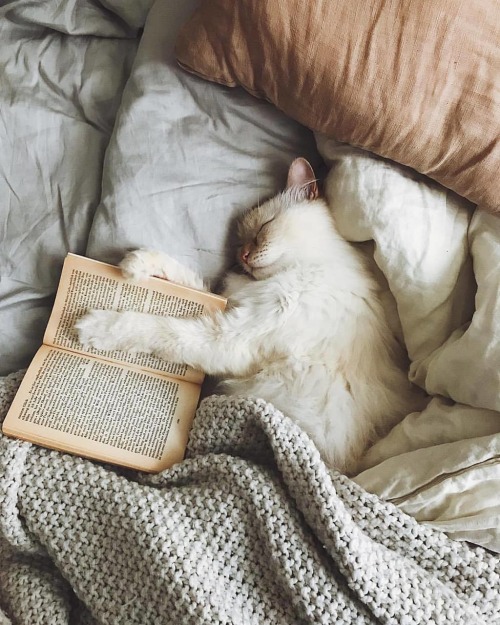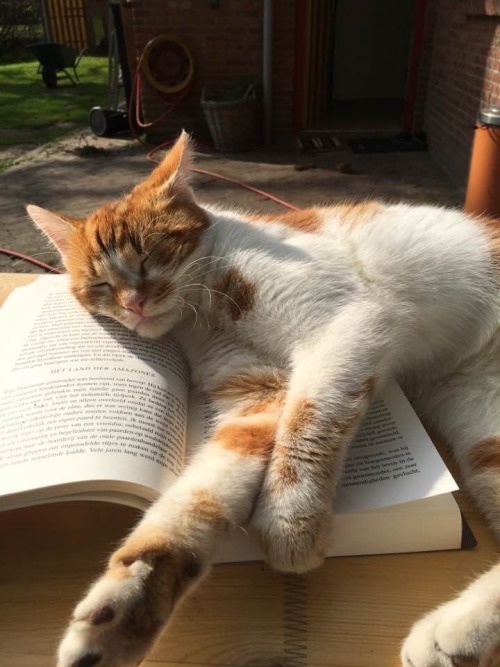Maybe This Is Why We Read, And Why In Moments Of Darkness We Return To Books: To Find Words For What
Maybe this is why we read, and why in moments of darkness we return to books: to find words for what we already know.
Alberto Manguel, Canadian translator and essayist
More Posts from Bibliobuddy and Others

Found my cat curled up in my blanket this morning and I just had to take advantage of the cuteness!
5 Great Articles About Reading
...to help you adapt the habit in our fast-changing world.
Your mom tells you to read. Your teacher or your boss tells you to read. Successful individuals tell you to read. They're right to tell you so.
For non-readers, it's not going to be an easy task. Reading is tedious. Sometimes a bit irksome, too. You find that words are drowning you in boredom and irritation before turning to the next page.
This is why I've collected a list of five helpful articles to aid you in reading actively, effectively, and habitually. Whether you're an avid bookworm like me or a stranger to pages, these articles can help you acquire the habit in our modern-day society.
1. How to Read the Right Way: A Complete Guide | Medium
Even books and reading evolve. In this article, author Melissa Chu tackles the art of speed reading, the pros and cons of different reading formats, and how to read in a changing society.
2. The Complete Guide to Effective Reading | Medium
Worry about memorizing dates for your history exam? Maarten van Doorn takes you into an in-depth analysis of acquiring information into your long-term memory, as well as how to read actively.
3. 14 Ways to Cultivate a Lifetime Reading Habit | Life Hack
Reading is a habit, not a chore. If it isn't one of your pastimes yet, don't worry! Life Hack presents to you 14 ways to make reading a pleasurable and worthwhile habit.
4. The Case for Reading Fiction | Harvard Business Review
Business and companies look for various skills and good characteristics in their employees. Harvard Business Review says that reading literary fiction can help you develop these in-demand traits, and ultimately become a better person.
5. Books are good for your brain. These techniques will help you read more | Popular Science
Here's the science behind the effects and benefits of reading. Popular Science shows you not only how to make reading a habit, but also how to read more and achieve your reading goal.
These are just some of the multitudes of articles I've found to help you learn to read. I hope this helps spark your inner reader!
Things we should do in English class instead of just Shakespeare:
Compare & contrast a Rick Riordan book, an original Greek myth, and/or a retelling like Song of Achilles
Instead of talking about poetic devices, look for imagery, symbolism, and color theory in comics/graphic novels/Webtoons (Lore Olympus is a great example!!)
Analyze a Broadway musical instead of a Shakespeare play. (There’s SO MUCH to unpack in Dear Evan Hansen)
Have half the class read a book, and the other half listen to the audiobook. Do the audiobook kids have more similar interpretations? How much does the inflection and (unsaid) thoughts of the narrator influence ones takeaway?
10k notes and I’ll show this to my English teacher
reading alone in your room at sunset with your windows open in summer while the wind caresses your skin is probably the closest thing we have to a cure for the human condition
how did you learn to write well?
well first you have to be a very sad child
We need more diverse books in literature. More voices need to be represented.



The Cooperative Children’s Book Center has released the results of their 2019 survey on diversity in kidlit/YA.
We thank them for this invaluable work, note their commitment to adding Arabs/Arab Americans in future surveys, and present these graphs of their findings.
The 3,716 books surveyed have this many main characters total for the following groups:
Black/African: 11.9%
First/Native Nations: 1%
Asian/Asian American: 8.7%
Latinx: 5.3%
Pacific Islander: 0.05%
White: 41.8%
Animal/Other: 29.2%
LGBTQIAP+: 3.1%
Disability: 3.4%
“Taken together, books about white children, talking bears, trucks, monsters, potatoes, etc. represent nearly three quarters (71%) of children’s and young adult books published in 2019.” - librarian Madeline Tyner
When we looked at the breakdown for IPOC creatives who wrote and/or illustrated stories with characters of their own race, we found the following:
First/Native Nations: 68.2%
Pacific Islander: 80%
Latinx: 95.7%
Asian/Asian American: 100%*
*NOTE: these percentages include both authors and illustrators and, as pointed out by author Linda Sue Park for past surveys, Asians/Asian Americans are frequently illustrators but not necessarily authors of their own stories, meaning this is not fully reflective of #OwnVoices representation.
Black/African creatives wrote and/or illustrated only 46.4% of stories featuring Black/African characters.
This is the work that still needs to be done.
Readers are the best weightlifters, then.
“Books have to be heavy because the whole world’s inside them.”
— Inkheart by Cornelia Funke
Books with cats make the best reading environment ♡




Leo Tolstoy sure does know what happiness is!
“Rest, nature, books, music… such is my idea of happiness.”
-Leo Tolstoy
-
 the-secret-of-this-world liked this · 1 year ago
the-secret-of-this-world liked this · 1 year ago -
 superbmoonprincess liked this · 2 years ago
superbmoonprincess liked this · 2 years ago -
 ya-husain liked this · 3 years ago
ya-husain liked this · 3 years ago -
 alezinmuggleland reblogged this · 3 years ago
alezinmuggleland reblogged this · 3 years ago -
 alezinmuggleland liked this · 3 years ago
alezinmuggleland liked this · 3 years ago -
 dismoilunedargent liked this · 3 years ago
dismoilunedargent liked this · 3 years ago -
 channy-banana liked this · 3 years ago
channy-banana liked this · 3 years ago -
 friesandnuggetsmakemehappy27 liked this · 3 years ago
friesandnuggetsmakemehappy27 liked this · 3 years ago -
 ouch8y liked this · 3 years ago
ouch8y liked this · 3 years ago -
 poetanasciturnonfir liked this · 3 years ago
poetanasciturnonfir liked this · 3 years ago -
 hu-rricane reblogged this · 4 years ago
hu-rricane reblogged this · 4 years ago -
 an-absolute-nightmare reblogged this · 4 years ago
an-absolute-nightmare reblogged this · 4 years ago -
 an-absolute-nightmare liked this · 4 years ago
an-absolute-nightmare liked this · 4 years ago -
 nada--personal reblogged this · 4 years ago
nada--personal reblogged this · 4 years ago -
 smay reblogged this · 4 years ago
smay reblogged this · 4 years ago -
 psychicplantphantom liked this · 4 years ago
psychicplantphantom liked this · 4 years ago -
 danasdreams liked this · 4 years ago
danasdreams liked this · 4 years ago -
 marxsound liked this · 4 years ago
marxsound liked this · 4 years ago -
 aragondaniela liked this · 4 years ago
aragondaniela liked this · 4 years ago -
 ungluecksmaedchen reblogged this · 4 years ago
ungluecksmaedchen reblogged this · 4 years ago -
 antiheldstillalive reblogged this · 4 years ago
antiheldstillalive reblogged this · 4 years ago -
 bibliobuddy reblogged this · 4 years ago
bibliobuddy reblogged this · 4 years ago

19 | random literature + bookblr stuff | dormant acc, used for interactions only | more active on @sunbeamrocks
60 posts

